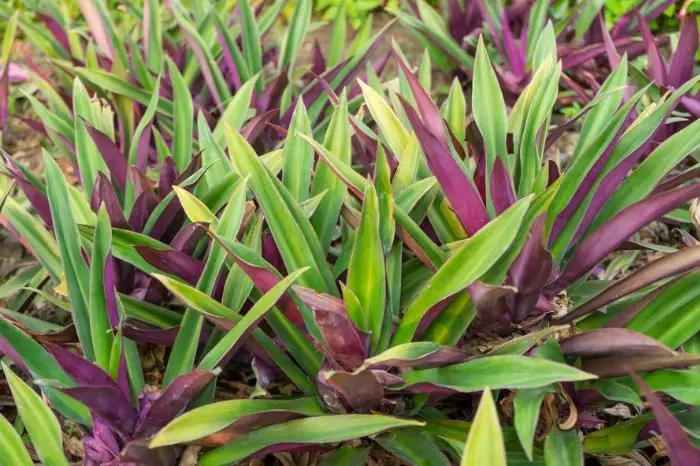Many of us love to have houseplants in our various homes because they give that sweet look to our space. There are so many houseplants to choose and some of them even come in different captivating colors. A plant with purple under leaves is what we will be looking at in this post.
These houseplants with purple underleaves give this warm texture and add a royal appeal to your indoor space. They can fit perfectly into your interiors and you can even grow them in combination with other green houseplants.
A plant with purple under leaves will be listed here so continue reading for some insight on this.
Plant With Purple Under Leaves: 7 Most Popular
Below is the list of some common houseplants with purple under leaves:
1. Oyster plant
A plant with purple under leaves that is quite popular is the oyster plant. The oyster plant originates from Mexico, Brazil, and Guatemala and this lovely plant is a resistant and hardy plant that can thrive well in containers. You can also grow this plant outdoors in your garden in areas with mild winters.
The leaves of the oyster plant stand erect and have a height of up to 6 inches long with purple reverse growing densely on the stem forming spiral rosettes.

The amount of light an oyster plant receives usually determines the color intensity. So, if this plant is positioned in a deep shade spot, it can lose its purple hues. However, don’t expose oyster plants to direct bright sunlight because this can scorch the plant.
Click Here to Get Info About:
2. Wandering jew – A plant with purple underleaves
Another popular houseplant with purple under leaves is Wandering Jew which is also known as Tradescantia Zebrina. Wandering Jew is a modest and durable houseplant with this charming and enchanting colored creeper that grows naturally in woodland and open fields in Mexico.
The plant is characterized by this oval, 3 to 4 inches long shiny leaves of silver-green stripes that are oppositely arranged. Its intensely colored leaves grow densely on watery and thick stems.
Wandering Jew houseplant is a perfect fit for hanging baskets and you can place it on your east and west windows, forming a two to three feet long colorful cascade. This plant is quite tolerant to most temperatures except for freezing temperatures. The plant is easy to grow and maintain and it’s great for beginners.
3. Calathea medallion
Calathea Medallion is also referred to as Calathea Veitchiana and this plant is one stunning plant with purple under leaves. The plant is from the Marantaceae family and it originates from the jungle of the Amazon and South America, where it grows under the shade of high tropical vegetation.
Calathea Medallion – 6″ from California Tropicals

You need to take care of this plant because the broad leaves tend to react strongly to adverse conditions. Hence, you must pay close attention by providing the plant with increased humidity levels, temperature between 65 to 80 degrees Fahrenheit, and moderately moist
4. Alocasia amazonica polly
Alocasia Amazonica Polly is a plant from the Araceae family. The plant is characterized by its large, arrow foliage with pronounced white nervation.
This plant may not be the easiest plant to grow, but it has this captivating look that makes the extra effort worth it. It is a plant with purple underleaves grown indoors.
However, note that the plant contains poisonous calcium oxalate and this can cause some health issues for both humans and pets.
Provide this houseplant with bright filtered light, a humid environment, and warm conditions. So, because this is a warm-loving plant, you will need to water it during its growing season at least two times a week. Then water once every 7-14 days during winter.
The plant doesn’t like dry air, non-permeable
Additionally, clean the shiny leather leaves regularly by using a moist cloth.
5. Gynura sarmentosa – Houseplants with purple underleaves
Gynura sarmentosa is a lovely houseplant that is characterized by its nettle-like leaves covered with thick purple hairs. The plant looks so velvety and refined and it grows naturally in tropical Asia as a small shrub with shoots that rely on each other. This plant is also great for a hanging basket and its stem will spread in all directions.
Gynura Sarmentosa thrives in warm and humid conditions. However, take note not to spray its hairy leaves.
6. Stromanthe sanguinea
Stromanthe Sanguinea features this artistic white and green colored leaf surface with this intense purple reverse. This intense purple reverse is mostly pronounced at night when the plant folds its leaves.
Care for this plant by providing it with bright but indirect sunlight, a humidity of at least 60%, well-draining
Check Out:
- How To Cut Off Small Monstera Leaves To Improve Its Look
- Troubleshooting Overwatered String Of Hearts
7. Cetenanthe plant
The cetenanthe plant is also referred to as the Never Never plant and it is from the Marantaceae family that comes from the rainforests of Northeast Brazil. The plant features this large silver-green striped oblong leaves that grow densely from the rhizome root.
This plant grows optimally in a partially shaded spot, with well-draining
Fuzzy Green Leaves With Purple Underneath – What is it?
You may see a plant that has fuzzy green leaves, with purple coloring (it can sometimes look almost maroon or burgundy) underneath. If this is the case, you’re probably looking at the Velvet Calathea (otherwise known as the Calathea Rufibarba). The leaves will be long, but thin. What’s interesting is that they’re hairy underneath, which is where they get their furry nickname from.
This particular plant is relatively easy to care for, but you need to ensure that it’s free from any pests often. And you’ll also need to ensure it receives the nutrients it requires. You should water this plant every five days or so and keep it n temperatures between 64F and 73F. While it can survive in slightly lower temperatures, it’s a tropical plant, so it does enjoy its humidity.
Green Leaves With Purple Veins – What Does This Mean?
Another plant that you may have seen has green leaves, that are covered in deep purple veins. If this is the case, you’re likely looking at the Fishnet Stockings Coleus. This plant gets its nickname from the veins themselves looking like stockings. However, the purple color does eventually change to green. This plant can grow up to around 2 feet in height.
Purple Leaf Perennials: Popular Varieties
There are many popular varieties of purple-leaf perennials. Let’s take a closer look at some of our top picks.
- Cercis canadensis. You may know this plant better by its nickname, forest pansy. It’s a versatile plant that can last up to 20 years and can reach up to 8 meters in height if provided with the right growing conditions. This plant enjoys the sun and should be kept in well-drained
soil . This plant changes colors throughout the year. Such as reddish leaves in Spring, burgundy leaves in Summer, and orange and gold in Autumn. - Cotinus. You may know this plant better by its nickname, royal purple. This is a shrub that has dark purple, oval-shaped, leaves. This plant enjoys the sun and will thrive in most types of soils. As long as it’s pruned often, this plant can grow up to 8 feet in height.
- Heuchera. You may know this plant better by its nickname, the midnight rose. This plant is the perfect mixture of both purple and vibrant pink…which doesn’t sit well with some gardeners. But, I, personally, love it! However, it can be quite prone to vine weevil, so it’s best to plant outdoors, in open ground. This plant enjoys full sun or dappled shade.

Purple Leaf Plant Identification
The best way to find out what purple leaf plant you have if you’re unsure, is using an app such as Plant Net Identify. Or try to find some other obvious markers to help identify which species your plant is. Most of the time, the term “purple” is used loosely, as it’s not often that the leaf of a plant is purely purple. It often has red highlights or other colored undertones. However, in previous years, gardeners have enjoyed adding purple-leaf plants to their gardens.
Additional Say: Plant With Purple Under Leaves
We have listed popular houseplants with purple under leaves and some details about them. However, note that there are many other types with these features. There are many to choose from, and all are just as gorgeous as the next! Do you know of any other plant with purple under the leaves? If so, please feel free to let us know in the comments below. And remember, sharing is caring!
FAQs
What plant has purple under the leaf?
Some of the common plants that have purple under their leaf include wandering Jew, oyster plant, calathea medallion, stromanthe sanguine, ctenanthe plant, gynura sarmentosa, and many more.
Why are leaves purple underneath?
Some plants naturally have purple leaves underneath. However, if your plant is not naturally purple underneath and it shows purple, then it may be a sign of phosphorous deficiency.
How do you fix purple leaves?
Fixing a plant that is showing purple leaves when it isn’t naturally purple means you have to deal with phosphorus deficiency. So, you will need to make pH adjustments and flush your plants with pH and nutrients containing phosphorus.
How do I identify a plant by its leaves?
You can identify a plant by its leaves if you closely look at the shape and size of the plant’s leaves. For instance, broad and wide leaves can signify that the plant is a tropical plant. Then pointy pine needles can signify that the plant is an evergreen species.




